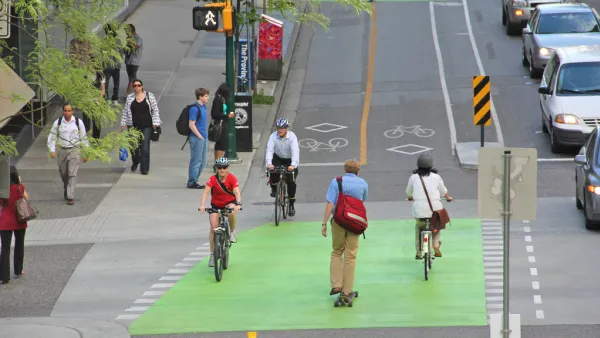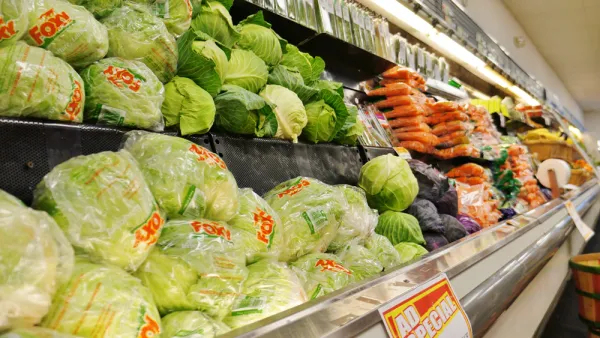Costco may be coming to Manhattan, bringing 2300 parking spaces with it.
Costco may be coming to Manhattan, bringing 2300 parking spaces with it.
In a city where high rents have driven out traditional grocery stores, some are welcoming the news. But is Costco the answer? Their buy-in-bulk business model is meant for big cars and big suburban homes. I don't see how this fits into Manhattan's car-free lifestyle, even if Costco modifies their building design for the urban landscape.
The role of neighborhood grocery stores in building and maintaining walkable communities cannot be overstated. European cities and towns simply would not be the pedestrian utopias that they are without the many small grocers, outdoor markets and specialty shops that make it possible to gather daily provisions without a car.
Small grocers are essential because:
• They fit well into walkable main streets.
• They are small enough to be located within residential communities.
• They don't require a huge parking lot
• They are close enough to housing so that shoppers can carry groceries home, or return several times a day if needed.
Can a neighborhood be considered mixed-use without a decent grocery store? And by decent, I am thinking of businesses that offer a basic variety of fresh, quality products at reasonable prices: Trader Joe's, Wild Oats, a trusted mom & pop grocer, or a local natural foods shop. Mid-sized grocery stores can also work well, provided that they are properly integrated into a city's shopping streets.
It's a common theme throughout suburban and even urban America: few residential neighborhoods are self sufficient when it comes to groceries. The ones that are lucky enough to have the "good stores" attract a lot of traffic from surrounding areas. The small grocery chain Fresh & Easy, subsidiary of the British Tesco empire, continues to expand in the southwestern United States. If the company targets locations that match the scale of its stores and have a walkable street grid, their venture could prove successful as the country trends away from suburban living.

National Parks Layoffs Will Cause Communities to Lose Billions
Thousands of essential park workers were laid off this week, just before the busy spring break season.

Retro-silient?: America’s First “Eco-burb,” The Woodlands Turns 50
A master-planned community north of Houston offers lessons on green infrastructure and resilient design, but falls short of its founder’s lofty affordability and walkability goals.

Delivering for America Plan Will Downgrade Mail Service in at Least 49.5 Percent of Zip Codes
Republican and Democrat lawmakers criticize the plan for its disproportionate negative impact on rural communities.

Test News Post 1
This is a summary

Test News Headline 46
Test for the image on the front page.

Balancing Bombs and Butterflies: How the National Guard Protects a Rare Species
The National Guard at Fort Indiantown Gap uses GIS technology and land management strategies to balance military training with conservation efforts, ensuring the survival of the rare eastern regal fritillary butterfly.
Urban Design for Planners 1: Software Tools
This six-course series explores essential urban design concepts using open source software and equips planners with the tools they need to participate fully in the urban design process.
Planning for Universal Design
Learn the tools for implementing Universal Design in planning regulations.
EMC Planning Group, Inc.
Planetizen
Planetizen
Mpact (formerly Rail~Volution)
Great Falls Development Authority, Inc.
HUDs Office of Policy Development and Research
NYU Wagner Graduate School of Public Service





























